Construction Condition and Damage Monitoring of Post-Tensioned PSC Girders Using Embedded Sensors
Abstract
:1. Introduction
2. Validation Test of Sensors
2.1. Experimental Program
2.1.1. Center-Hole Load Cell
2.1.2. Tri-Sensor Loading Plate
2.1.3. Hydraulic Load Cell
2.1.4. FBG Sensor
2.2. Test Method and Equipment
2.3. Test Results
2.3.1. General Behavior
2.3.2. Center-Hole Load Cell
2.3.3. Hydraulic Load Cell
2.3.4. Tri-Sensor Loading Plate
2.3.5. FBG Sensor
3. Construction Process and Damage Monitoring of PSC Girders
3.1. Experimental Program with PSC Girders
3.2. Test Results: Construction Stage
3.2.1. Pre-Stressing Stage
3.2.2. Yard Storage Stage and Pre-Stress Losses
3.3. Test Results: Loading Stage
3.3.1. General Behavior
3.3.2. Test Results: Pre-Stress Forces and Damage
3.3.3. Test Results: Tendon Strain and Damage
4. Conclusions
Acknowledgments
Author Contributions
Conflicts of Interest
References
- Nilson, A.H. Design of Prestressed Concrete; Wiley: Hoboken, NJ, USA, 1987. [Google Scholar]
- American Concrete Institute (ACI) Committee 318. Building Code Requirements for Structural Concrete (ACI 318–14); American Concrete Institute (ACI): Farmington Hills, MI, USA, 2014. [Google Scholar]
- Euro-International Committee for Concrete (CEB). CEB-FIP Model Code; Thomas Telford Services Ltd.: Lausanne, Switzerland, 1993. [Google Scholar]
- Barr, P.J.; Kukay, B.M.; Halling, M.W. Comparison of prestress losses for a prestress concrete bridge made with high-performance concrete. J. Bridge Eng. 2008, 13, 468–475. [Google Scholar] [CrossRef]
- Jain, S.K.; Goel, S.C. Discussion of “prestress force effect on vibration frequency of concrete bridges”. J. Struct. Eng. 1996, 122, 458–460. [Google Scholar] [CrossRef]
- Joh, C.; Lee, J.W.; Kwahk, I. Feasibility study of stress measurement in prestressing tendons using villari effect and induced magnetic field. Int. J. Distrib. Sens. Netw. 2013, 9. [Google Scholar] [CrossRef]
- Chaki, S.; Bourse, G. Guided ultrasonic waves for nondestructive monitoring of the stress levels in prestressed steel strands. Ultrasonics 2009, 49, 162–171. [Google Scholar] [CrossRef] [PubMed]
- Salamone, S.; Bartoli, I.; Phillips, R.; Nucera, C.; Scalea, F.L. Health monitoring of prestressing tendons in posttensioned concrete bridges. J. Transp. Res. Board 2011, 2220, 21–27. [Google Scholar] [CrossRef]
- Wang, M.L.; Chen, Z.L.; Koontz, S.S. Magnetoelastic method of stress monitoring in steel tendons and cables. In Proceedings of the SPIE—Nondestructive Evaluation of Highways, Utilities, and Pipelines IV, Newport Beach, CA, USA, 7–9 March 2000; Volume 395, pp. 492–500. [Google Scholar]
- Zhao, Y.; Wang, M.L. Non-destructive condition evaluation of stress in steel cable using magnetoelastic technology. In Proceedings of the SPIE—The International Society for Optical Engineering, San Diego, CA, USA, 27 February–2 March 2006; Volume 6178, pp. 1–7. [Google Scholar]
- Sumitro, S.; Jaroševic, A.; Wang, M.L. Elasto-magnetic sensor utilization on steel cable stress measurement. In Proceedings of the 1st Fib Congress: Concrete Structures in the 21th Century, Osaka, Japan, 13–19 October 2002. [Google Scholar]
- Cho, K.; Park, S.Y.; Cho, J.-R.; Kim, S.T.; Park, Y.-H. Estimation of prestress force distribution in themulti-strand system of prestressed concrete structures. Sensors 2015, 15, 14079–14092. [Google Scholar] [CrossRef] [PubMed]
- Li, H.-N.; Li, D.-S.; Song, G.-B. Recent applications of fiber optic sensors to health monitoring in civil engineering. Eng. Struct. 2004, 26, 1647–1657. [Google Scholar] [CrossRef]
- Ye, X.; Su, Y.; Han, J. Structural health monitoring of civil infrastructure using optical fiber sensing technology: A comprehensive review. Sci. World J. 2014, 2014. [Google Scholar] [CrossRef] [PubMed]
- Bao, X.; Chen, L. Recent progress in Brillouin scattering based fiber sensors. Sensors 2011, 11, 4152–4187. [Google Scholar] [CrossRef] [PubMed]
- Maaskant, R.; Alavie, T.; Measures, R.; Tadros, G.; Rizkalla, S.; Guha-Thakurta, A. Fiber-optic Bragg grating sensors for bridge monitoring. Cem. Concr. Compos. 1997, 19, 21–33. [Google Scholar] [CrossRef]
- Moyo, P.; Brownjohn, J.; Suresh, R.; Tjin, S. Development of fiber Bragg grating sensors for monitoring civil infrastructure. Eng. Struct. 2005, 27, 1828–1834. [Google Scholar] [CrossRef]
- Majumder, M.; Gangopadhyay, T.K.; Chakraborty, A.K.; Dasgupta, K.; Bhattacharya, D.K. Fibre Bragg gratings in structural health monitoring—Present status and applications. Sens. Actuators A Phys. 2008, 147, 150–164. [Google Scholar] [CrossRef]
- Zhou, Z.; Graver, T.W.; Hsu, L.; Ou, J. Techniques of advanced FBG sensors: Fabrication, demodulation, encapsulation and their application in the structural health monitoring of bridges. Pac. Sci. Rev. 2003, 5, 116–121. [Google Scholar]
- Kim, S.T.; Park, Y.; Park, S.Y.; Cho, K.; Cho, J.-R. A sensor-type PC strand with an embedded FBG sensor for monitoring prestress forces. Sensors 2015, 15, 1060–1070. [Google Scholar] [CrossRef] [PubMed]
- Zhou, Z.; He, J.P.; Ou, J.P. Long-term monitoring of a civil defensive structure based on distributed Brillouin optical fiber sensor. Pac. Sci. Rev. 2008, 8, 1–6. [Google Scholar]
- Lan, C.; Zhou, Z.; Ou, J. Full-scale prestress loss monitoring of damaged RC structures using distributed optical fiber sensing technology. Sensors 2012, 12, 5380–5394. [Google Scholar] [CrossRef] [PubMed]
- Kim, J.M.; Kim, H.W.; Park, Y.H.; Yang, I.H.; Kim, Y.S. FBG sensors encapsulated into 7-wire steel strand for tension monitoring of a prestressing tendon. Adv. Struct. Eng. 2012, 15, 907–917. [Google Scholar] [CrossRef]
- Kim, J.M.; Kim, C.M.; Choi, S.Y.; Lee, B.Y. Enhanced strain measurement range of an FBG sensor embedded in seven-wire steel strands. Sensors 2017, 17. [Google Scholar] [CrossRef] [PubMed]
- Shin, K.J.; Park, Y.U.; Lee, S.C.; Kim, Y.Y.; Lee, H.W. Experimental evaluation of prestress force in tendons for prestressed concrete girders using sensors. J. Comput. Struct. Eng. Inst. Korea 2015, 28, 715–722. [Google Scholar] [CrossRef]
- Kim, J.K.; Kim, J.M.; Lee, H.W.; Park, S.H.; Choi, S.Y.; Shin, K.J. ANN based tensile force estimation for pre-stressed tendons of PSC girders using FBG/EM hybrid sensing. Struct. Control Health Monitor. 2016, in press. [Google Scholar]
- Lee, S.C.; Choi, S.Y.; Shin, K.J.; Kim, J.M.; Lee, H.W. Measurement of transfer length for a seven-wire strand with FBG sensors. J. Comput. Struct. Eng. Inst. Korea 2015, 28, 707–714. [Google Scholar] [CrossRef]
- Lee, S.C.; Shin, K.J.; Kim, J.M.; Lee, H.W. Damage detection with FBG sensors for pre-stress concrete girders. Key Eng. Mater. 2017, 737, 454–458. [Google Scholar] [CrossRef]
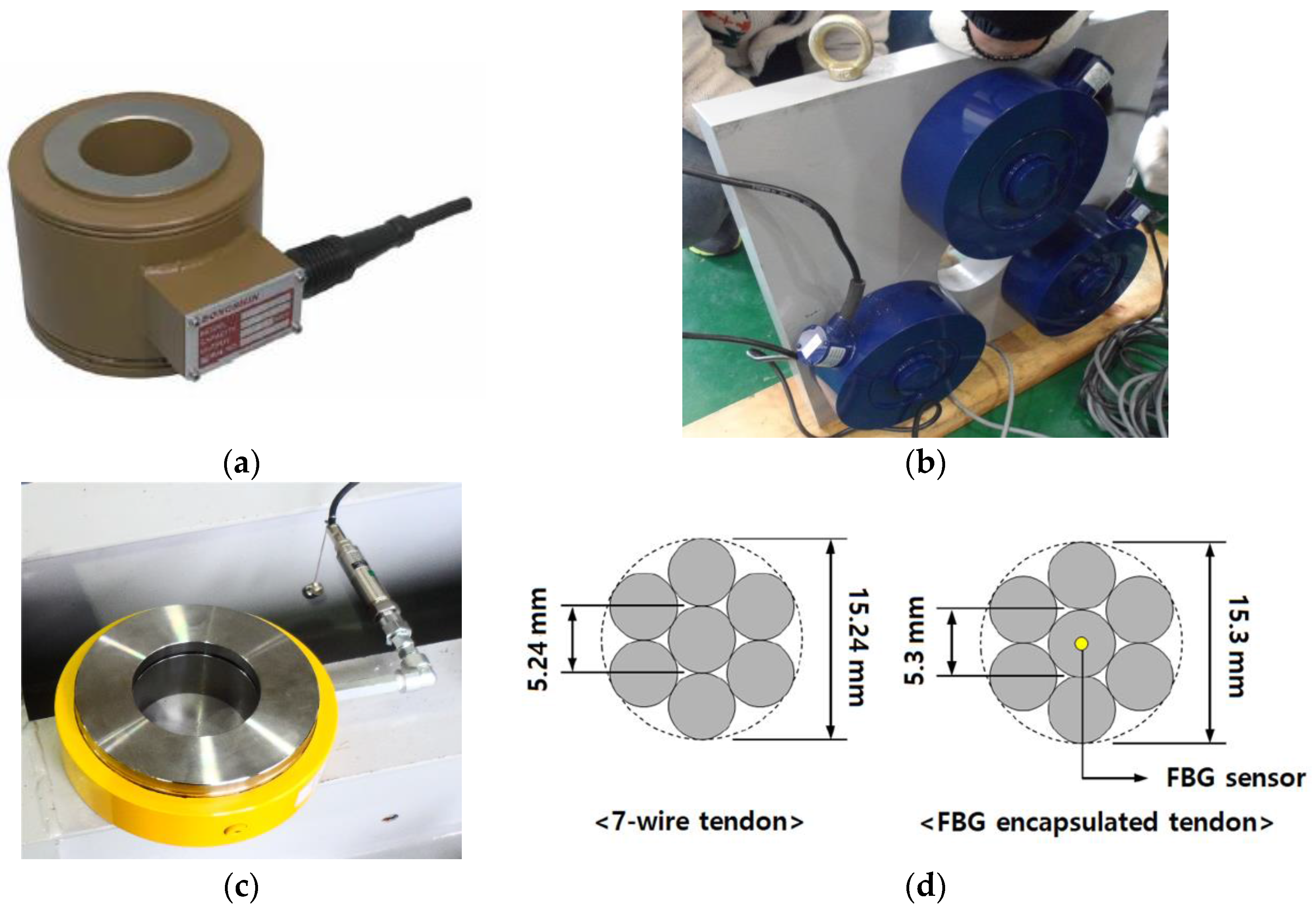

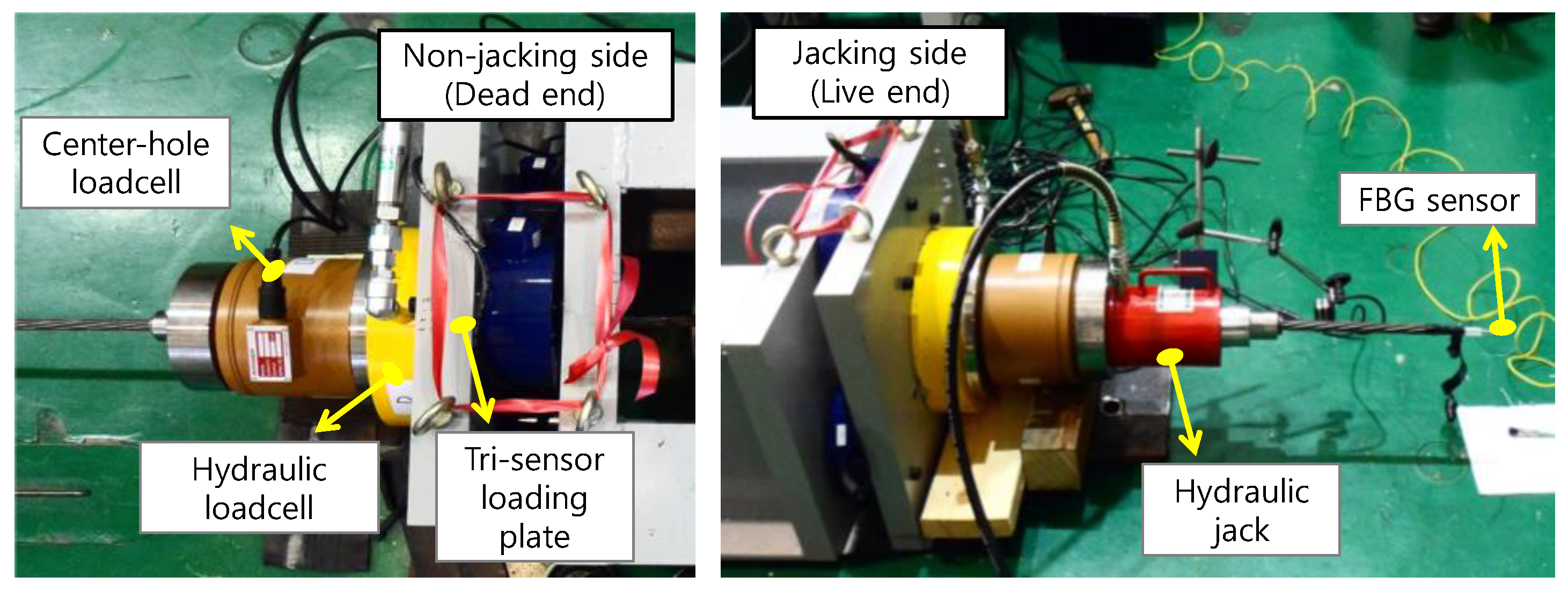
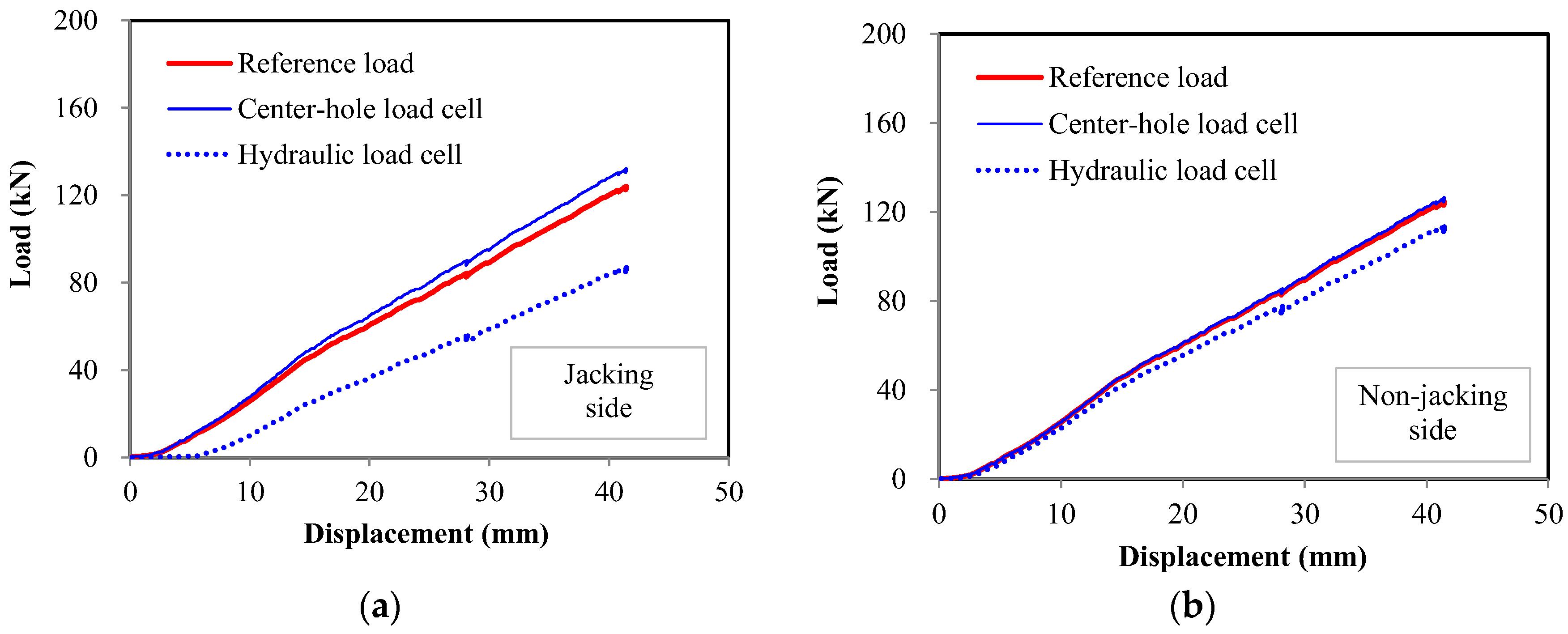
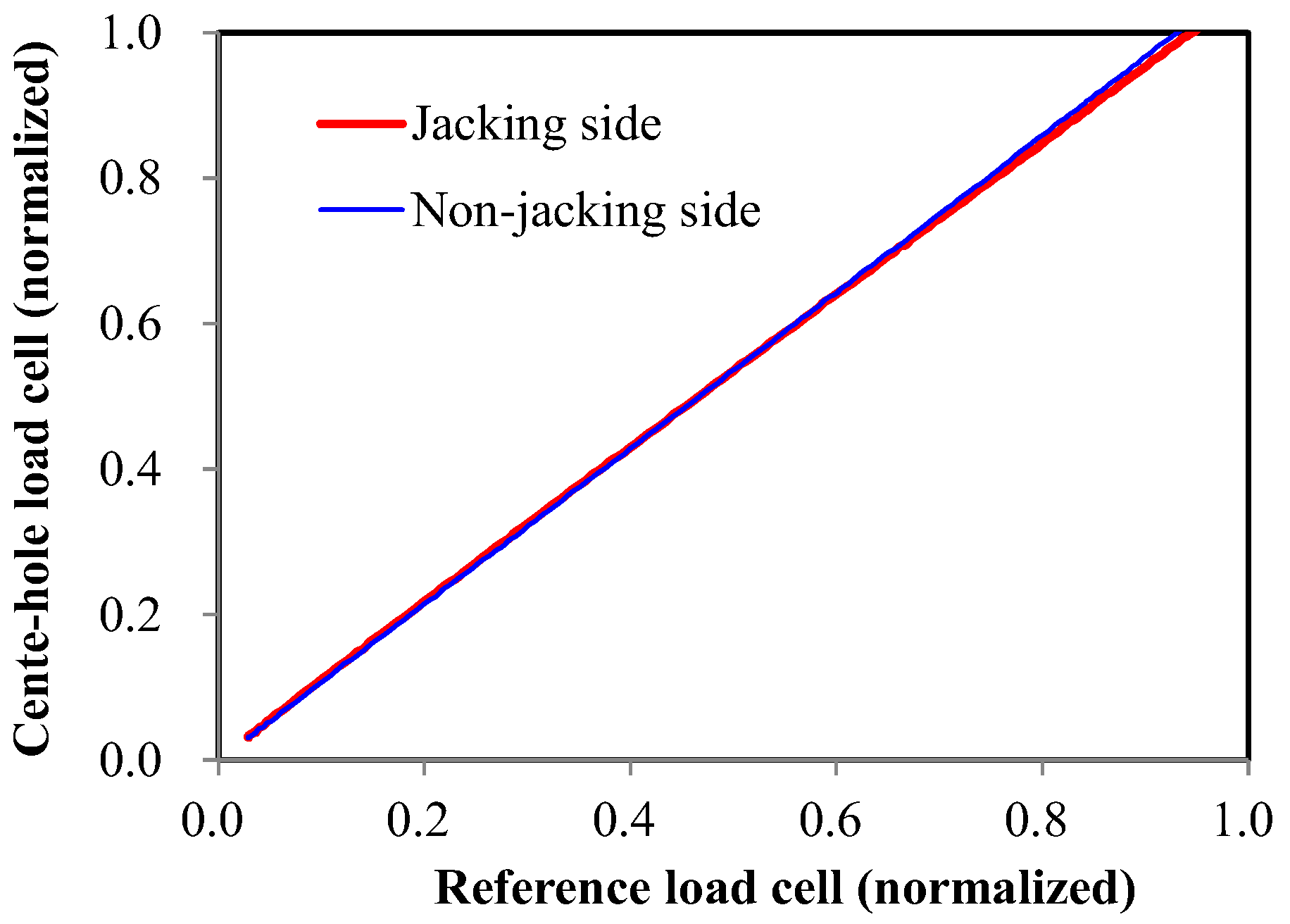
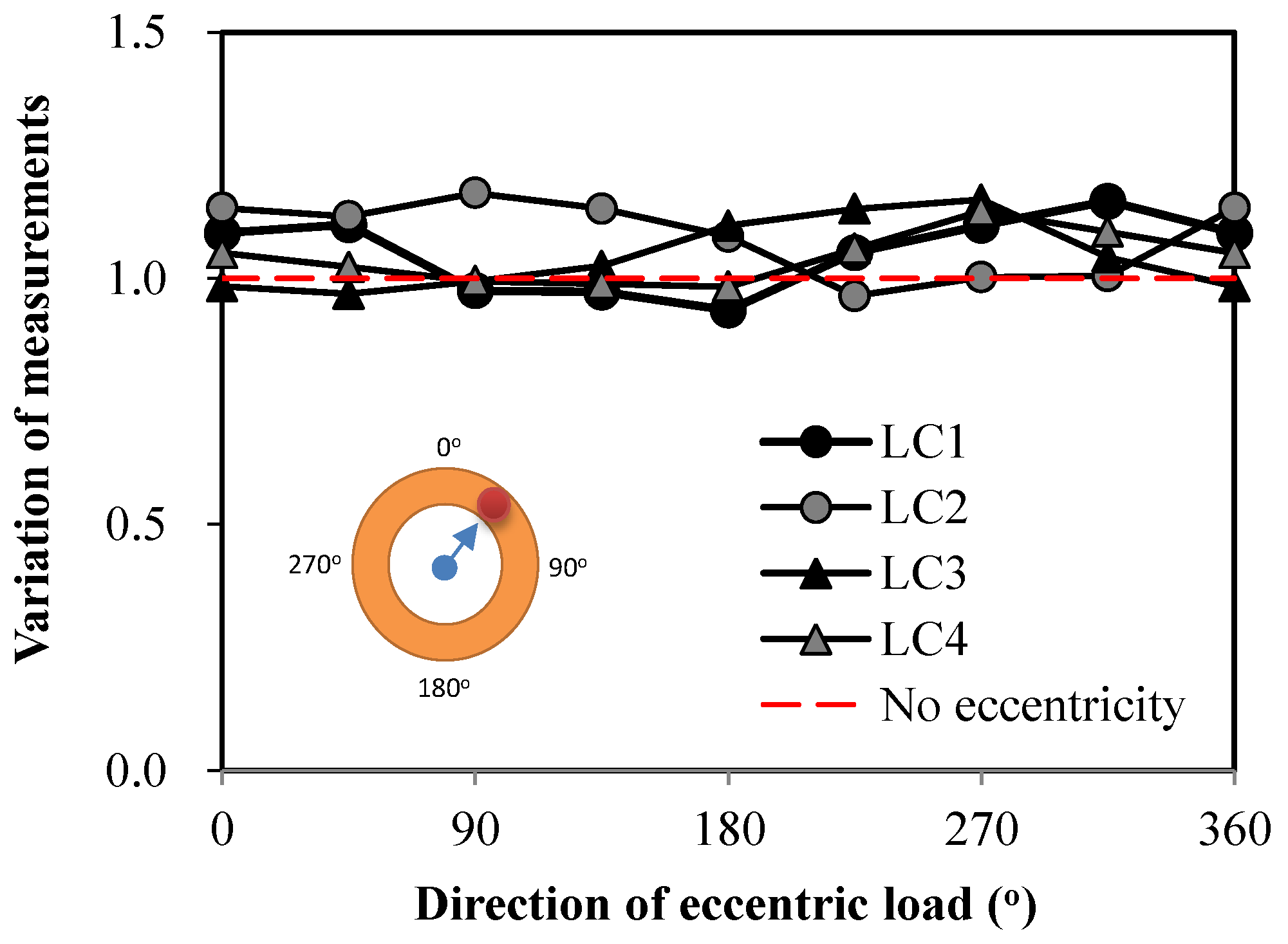
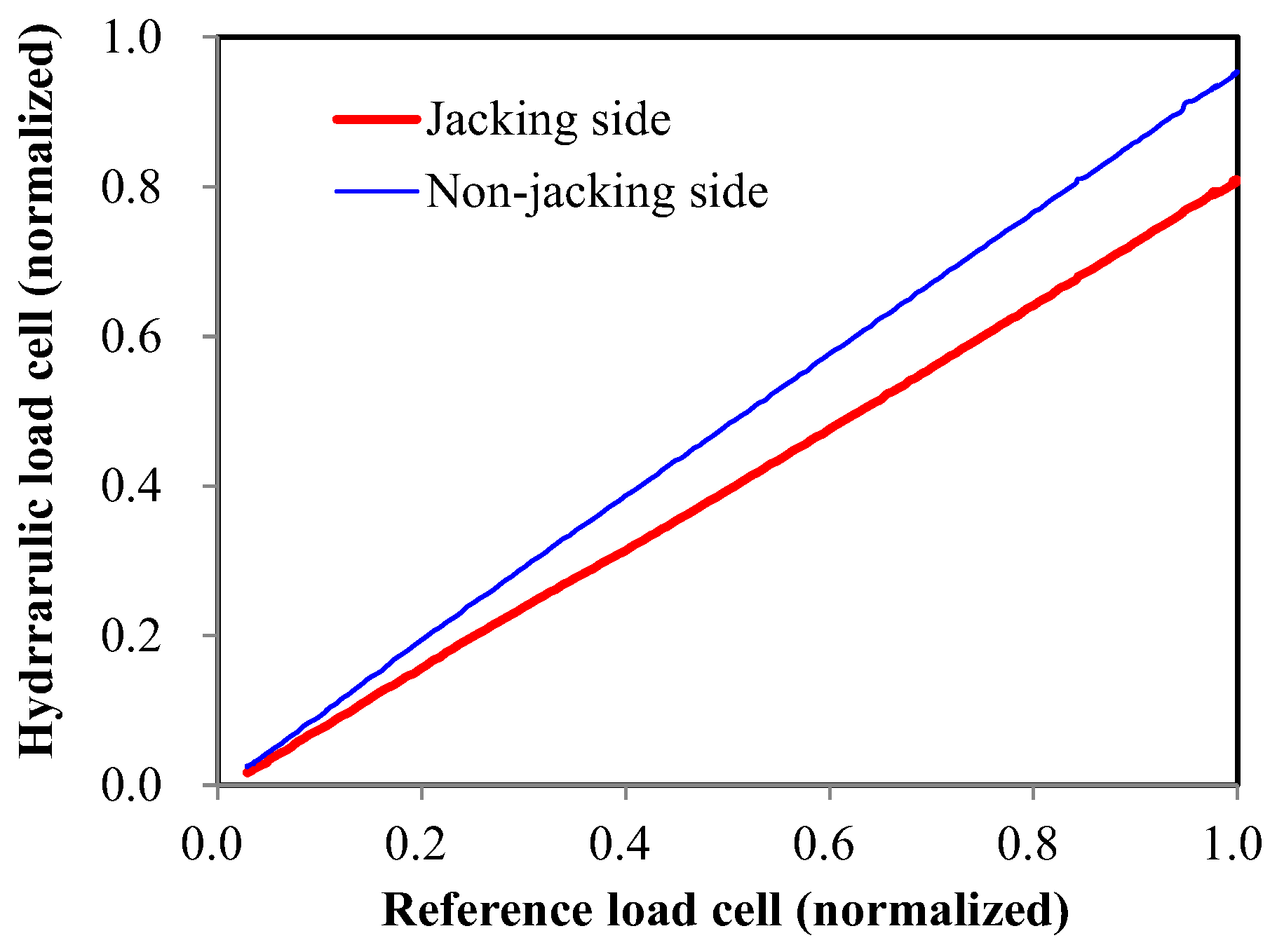


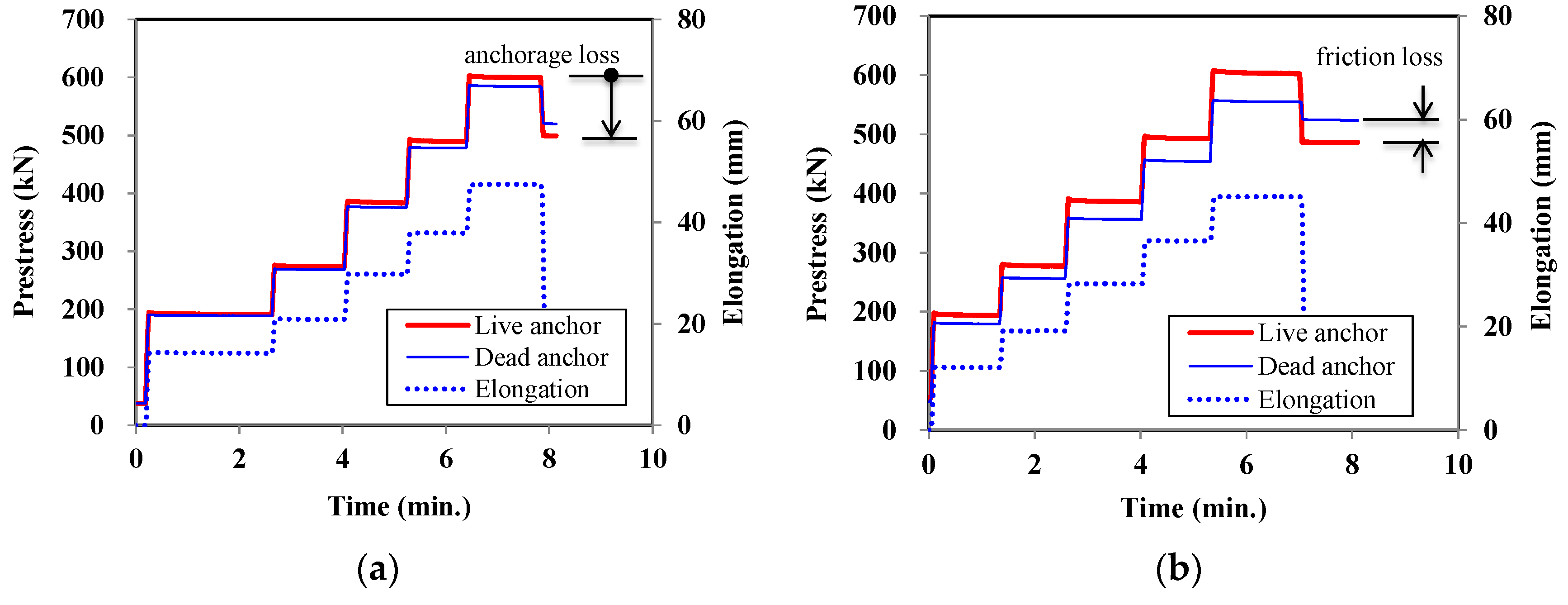
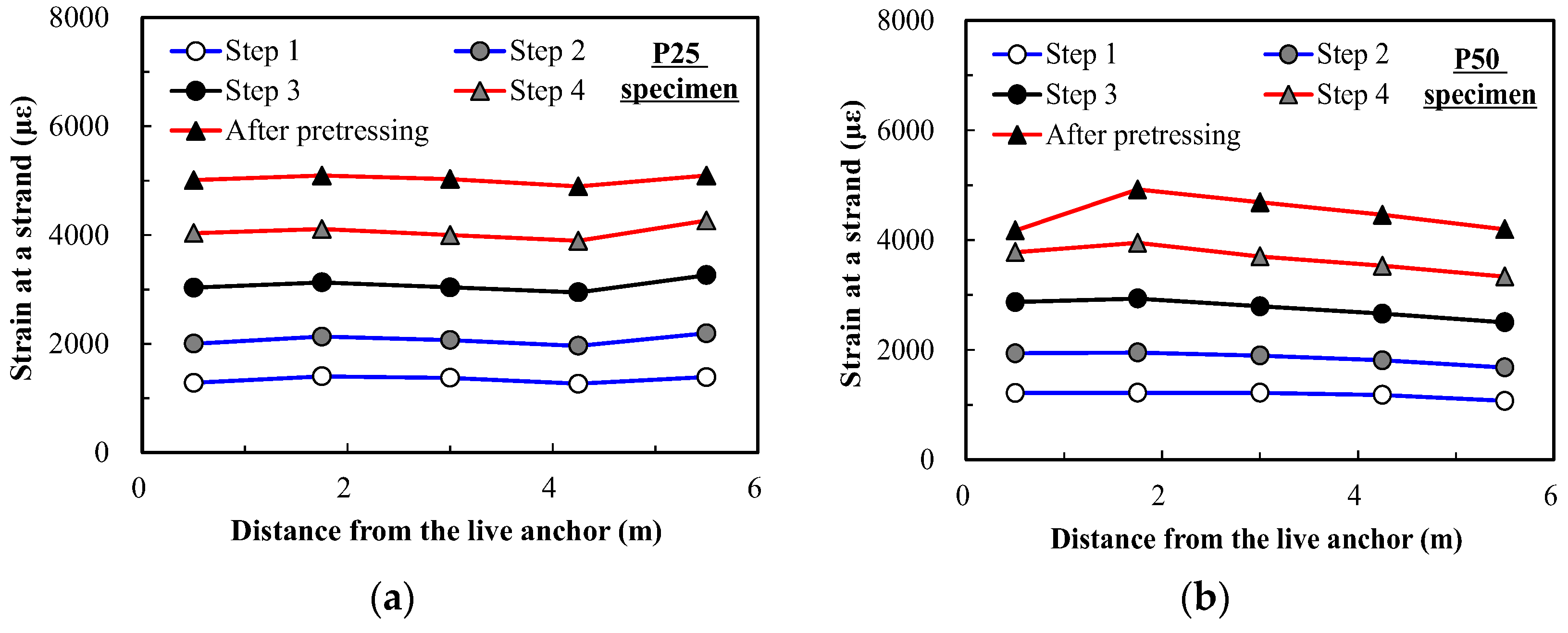
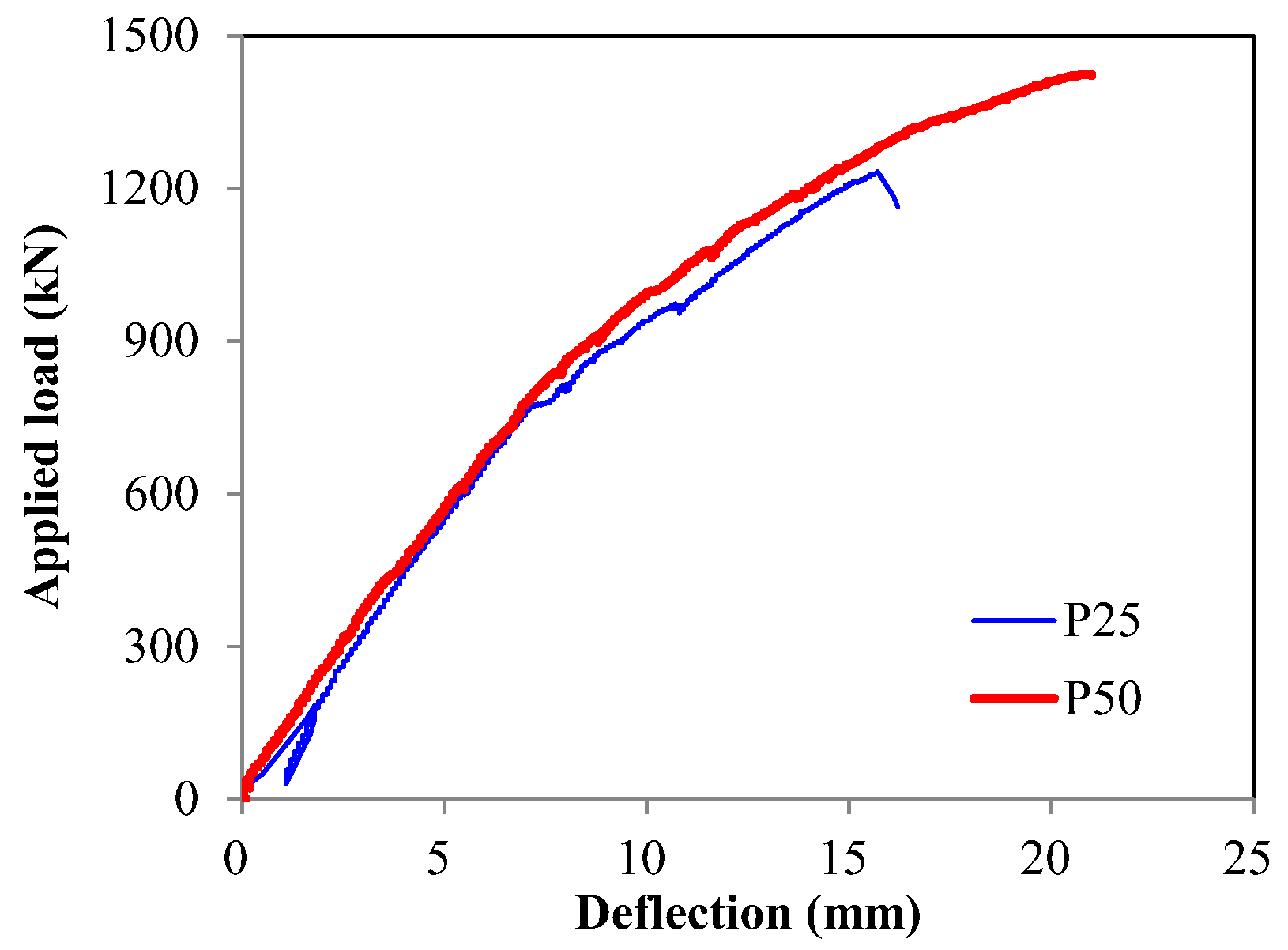

| P25 Specimen | LL (kN) | FBG1 (με) | FBG2 (με) | FBG3 (με) | FBG4 (με) | FBG5 (με) | LD (kN) |
| Initial (A) | 0 | 0 | 0 | 0 | 0 | 0 | 0 |
| Jacking (B) | 600 | 5009 | 5091 | 5030 | 4894 | 5092 | 585 |
| After anchoring (C) | 500 | 4153 | 4292 | 4342 | 4255 | 4555 | 520 |
| Before loading test (D) | 467 | 3682 | 3532 | 3824 | 3753 | 3645 | 479 |
| Jacking loss (1-B/C) | 16.7 | 17.1 | 15.7 | 13.7 | 13.0 | 10.6 | 11.1 |
| Long term loss (1-D/C) | 6.6 | 11.3 | 17.7 | 11.9 | 11.8 | 20.0 | 7.9 |
| P50 Specimen | LL (kN) | FBG1 (με) | FBG2 (με) | FBG3 (με) | FBG4 (με) | FBG5 (με) | LD (kN) |
| Initial (A) | 0 | 0 | 0 | 0 | 0 | 0 | 0 |
| Jacking (B) | 603 | 4172 | 4919 | 4687 | 4459 | 4195 | 555 |
| After anchoring (C) | 487 | 3038 | 3900 | 3933 | 4153 | 4000 | 524 |
| Before loading test (D) | 468 | 2790 | 3348 | 3517 | 4000 | 3253 | 464 |
| Jacking loss (1-B/C) | 19.2 | 27.2 | 20.7 | 16.1 | 6.9 | 4.7 | 5.6 |
| Long term loss (1-D/C) | 3.9 | 8.2 | 14.2 | 10.6 | 3.7 | 18.7 | 11.5 |
© 2017 by the authors. Licensee MDPI, Basel, Switzerland. This article is an open access article distributed under the terms and conditions of the Creative Commons Attribution (CC BY) license (http://creativecommons.org/licenses/by/4.0/).
Share and Cite
Shin, K.-J.; Lee, S.-C.; Kim, Y.Y.; Kim, J.-M.; Park, S.; Lee, H. Construction Condition and Damage Monitoring of Post-Tensioned PSC Girders Using Embedded Sensors. Sensors 2017, 17, 1843. https://doi.org/10.3390/s17081843
Shin K-J, Lee S-C, Kim YY, Kim J-M, Park S, Lee H. Construction Condition and Damage Monitoring of Post-Tensioned PSC Girders Using Embedded Sensors. Sensors. 2017; 17(8):1843. https://doi.org/10.3390/s17081843
Chicago/Turabian StyleShin, Kyung-Joon, Seong-Cheol Lee, Yun Yong Kim, Jae-Min Kim, Seunghee Park, and Hwanwoo Lee. 2017. "Construction Condition and Damage Monitoring of Post-Tensioned PSC Girders Using Embedded Sensors" Sensors 17, no. 8: 1843. https://doi.org/10.3390/s17081843






